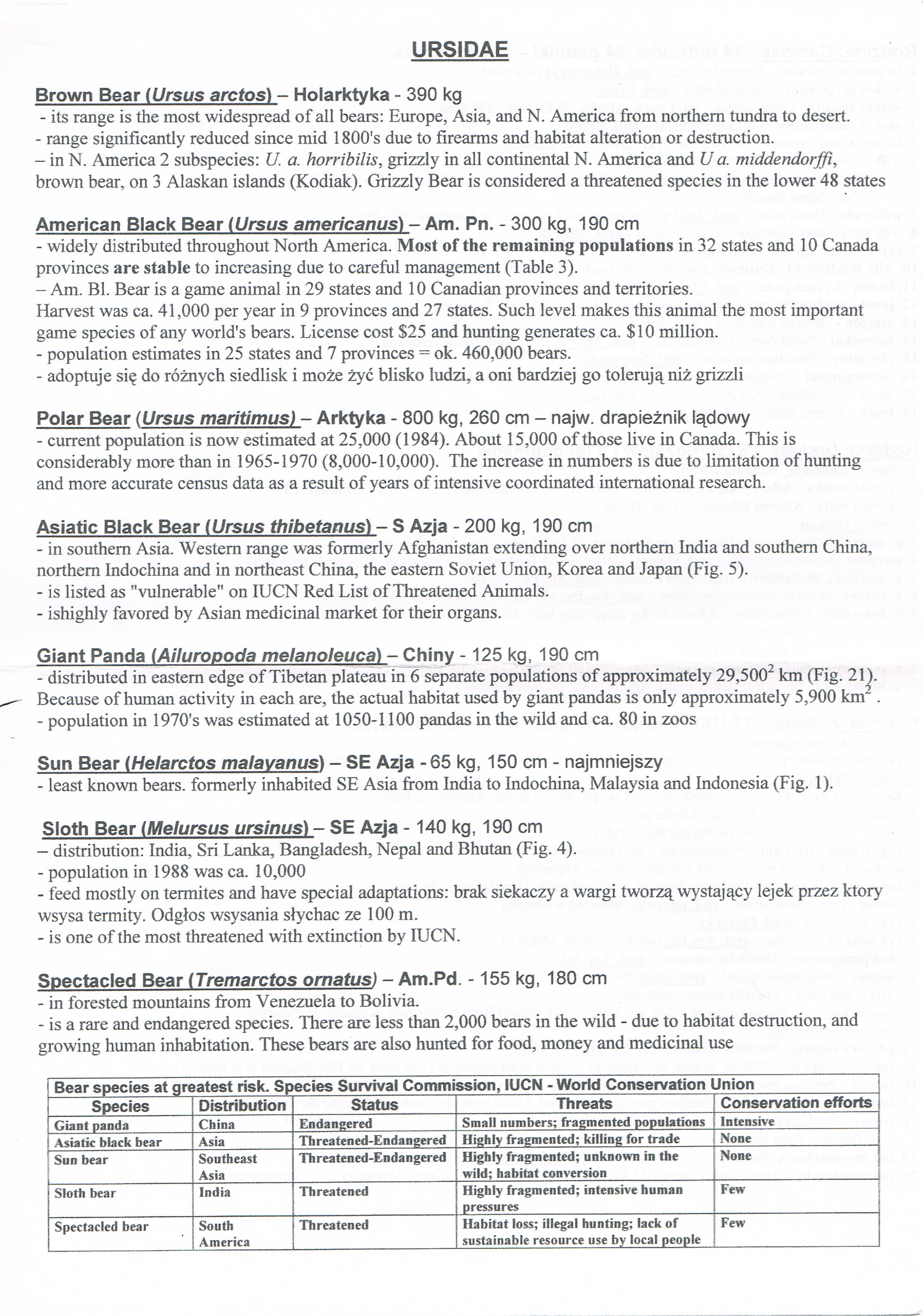CCF20150916�006 (2)

URSIDAE
Brown Bear (Ursus arctos) - Holarktyka - 390 kg
- its rangę is the most widespread of all bears: Europę, Asia, and N. America from northern tundra to desert.
- rangę significantly reduced sińce mid 1800's due to firearms and habitat alteration or destruction.
- in N. America 2 subspecies: U. a. horribilis, grizzly in all Continental N. America and U a. middendorjfi, brown bear, on 3 Alaskan islands (Kodiak). Grizzly Bear is considered a threatened species in the lower 48 States
American Black Bear (Ursus americanus) - Am. Pn. - 300 kg, 190 cm
- widely distributed throughout North America. Most of the remaining populations in 32 States and 10 Canada provinces are stable to increasing due to careful management (Table 3).
- Am. BI. Bear is a gamę animal in 29 States and 10 Canadian provinces and territories.
Harvest was ca. 41,000 per year in 9 provinces and 27 States. Such level makes this animal the most important gamę species of any world's bears. License cost S25 and hunting generates ca. $10 million.
- population estimates in 25 States and 7 provinces = ok. 460,000 bears.
- adoptuje się do różnych siedlisk i może żyć blisko ludzi, a oni bardziej go tolerują niż grizzli
Polar Bear (Ursus maritimus) - Arktyka - 800 kg, 260 cm - najw. drapieżnik lądowy
- current population is now estimated at 25,000 (1984). About 15,000 of those live in Canada. This is considerably morę than in 1965-1970 (8,000-10,000). The increase in numbers is due to limitation of hunting and morę accurate census data as a result of years of intensive coordinated intemational research.
Asłatic Black Bear (Ursus thibetanus) - S Azja - 200 kg, 190 cm
- in Southern Asia. Western rangę was formerly Afghanistan extending over northern India and southem China, northern Indochina and in northeast China, the eastem Soviet Union, Korea and Japan (Fig. 5).
- is listed as "vulnerable" on IUCN Red List of Threatened Animals.
- ishighly favored by Asian medicinal market for their organs.
Giant Panda (Ailuropoda melanoleuca) - Chiny -125 kg, 190 cm
- distributed in eastern edge of Tibetan plateau in 6 separate populations of approximately 29,5002 km (Fig. 21). Because of human activity in each are, the actual habitat used by giant pandas is only approximately 5,900 km" .
- population in 1970's was estimated at 1050-1100 pandas in the wild and ca. 80 in zoos
Sun Bear (Helarctos malayanus) - SE Azja - 65 kg, 150 cm - najmniejszy
- least known bears. formerly inhabited SE Asia from India to Indochina, Malaysia and Indonesia (Fig. 1).
Sloth Bear (Melursus ursinus) - SE Azja - 140 kg, 190 cm
- distribution: India, Sri Lanka, Bangladesh, Nepal and Bhutan (Fig. 4).
- population in 1988 was ca. 10,000
- feed mostly on termites and have special adaptations: brak siekaczy a wargi tworzą wystający lejek przez który wsysa termity. Odgłos wsysania słychac ze 100 m.
- is one of the most threatened with extinction by IUCN.
Spectacled Bear f Tremarctos omatus) - Am.Pd. -155 kg, 180 cm
- in forested mountains from Venezuela to Bolivia.
- is a rare and endangered species. There are less than 2,000 bears in the wild - due to habitat destruction, and growing human inhabitation. These bears are also hunted for food, money and medicinal use
|
Bear species at greatest risk. Species Survival Commission, IUCN - World Conservation |
Jnion | |||
|
Species |
Distribution |
Status |
Threats |
Conservation efforts |
|
Giant panda |
China |
Endangered |
Smali numbers; fragmented populations |
Intensive |
|
i Asiatic biack bear |
Asia |
Threatened-Endangered |
Highly fragmented; killing for trade |
Nonę |
|
Sun bear |
Southeast Asia |
Th reatened-Endan gered |
Highly fragmented; unknown in the wild; habitat conversion |
Nonę _____i |
|
Sloth bear |
India |
Threatened |
Highly fragmented; intensive human pressures |
Few |
|
Spectacled bear |
South America |
Threatened |
Habitat loss; illegal hunting; lack of sustainable resource use by local people |
Few |
Wyszukiwarka
Podobne podstrony:
CCF20100216�004 12 English Phonetics and Phonology ii) In making the two vowels described above, it
CCF20100216�004 12 English Phonetics and Phonology ii) In making the two vowels described above, it
img10 NIEDŹWIEDŹ BRUNATNY GRIZZLY (Ursus arctos horribilis) Ten północnoamerykański, wielki, szary
CCF20101005�002 2.2. Wyznacznik m Pf m =a, 100 1- Go» a:CL 100 kg.m 3. Obliczeni
CCF20130410�011 Szybkość przepływu masy mleka w wewnętrznej rurze (kg/s) Szybkość przepływ
Niedźwiedź (Ursus arctos) • Drapieżny ssak z rodziny niedźwiedziowatych. Sierść gęsta, barwy
img1225 1 DIAGRAM TIIREE The Sun. One of the 7 stars of the Great Bear. One of the 7 rays. Thre
f Fig. 12 Lifting and carrying meat and boxes is frequent. Manuał lifting of 75 kg ocajrs and one ma
the bagasse of 7738 ± 100 kj/kg, as received. However, in most sugar mills, it is not possible to ca
V)UŁvVS U T ? t"ovg.Tw£ . THE Fo* IS THE Boy.. The Fsu s osi the 3>vsh. The BEAR l$ ok
więcej podobnych podstron